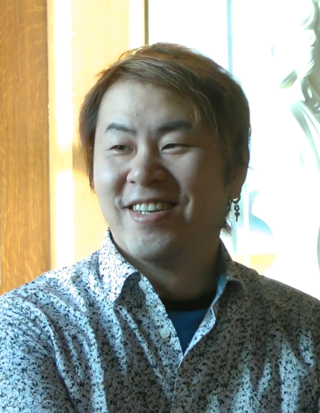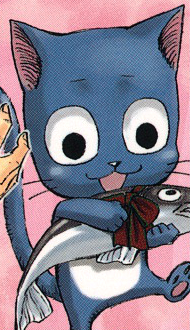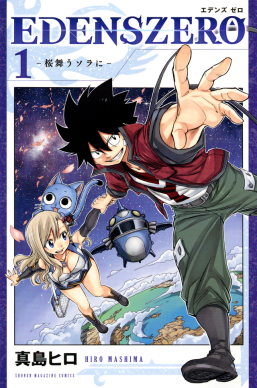
Hiro Mashima is a Japanese manga artist. He gained success with his first serial Rave Master, published in Kodansha's Weekly Shōnen Magazine from 1999 to 2005. His best-selling work, Fairy Tail, published in the same magazine from 2006 to 2017, became one of the best-selling manga series with over 72 million copies in print. Mashima began the currently ongoing Edens Zero in 2018.
Tetsuya Kakihara is a Japanese voice actor and singer. He was affiliated with 81 Produce before he became a freelancer in June 2013. He set up his own agency, Zynchro, in July 2014.

Fairy Tail is a Japanese manga series written and illustrated by Hiro Mashima. It was serialized in Kodansha's Weekly Shōnen Magazine from August 2006 to July 2017, with the individual chapters collected and published into 63 tankōbon volumes. The story follows the adventures of Natsu Dragneel, a member of the popular wizard guild Fairy Tail, as he searches the fictional world of Earth-land for the dragon Igneel.

Natsu "Salamander" Dragneel is a fictional character and protagonist of the Fairy Tail manga series created by Hiro Mashima. First making his debut in Fairy Tail chapter #1, "The Fairy's Tail", originally published in Japan's Weekly Shōnen Magazine on August 2, 2006, Natsu is depicted throughout the story as a member of the eponymous wizards' guild, who are notorious in the fictional Kingdom of Fiore for their numerous accounts of causing unintentional property damage with their magic. Being a Dragon Slayer, Natsu possesses the same abilities as his foster father, the dragon Igneel, namely the ability to consume and envelop himself in fire. Natsu's predominant role in the series is to reunite with Igneel, who has been missing for seven years by the story's outset. He appears in most Fairy Tail media, including both feature films, all original video animations (OVAs), light novels, and video games. He is voiced by Tetsuya Kakihara in Japanese, while Todd Haberkorn voices him in the English dub.

Lucy Heartfilia is a fictional character from Hiro Mashima's manga series Fairy Tail. Lucy first makes her debut in Fairy Tail chapter #1, "The Fairy's Tail", originally published in Japan's Weekly Shōnen Magazine on August 2, 2006, as a teenage wizard and aspiring novelist who joins the titular guild because of its popularity, despite its members' tendency to cause unintentional property damage. As a celestial wizard, Lucy uses magical objects known as Gatekeys to summon celestial spirits, beings from another world that possess various abilities, such as powerful zodiac spirits that she summons with rare golden keys. Lucy's initial weapon is a whip with a heart-shaped extremity, which is later switched to an extendable celestial whip. Lucy appears in most Fairy Tail media, including both feature films, all original video animations (OVAs), light novels and video games. She is voiced by Aya Hirano in Japanese, while Cherami Leigh voices her in the English dub.

Fairy Tail the Movie: Phoenix Priestess is a 2012 Japanese animated fantasy action comedy film and the first based on the manga series Fairy Tail by Hiro Mashima. It was directed by Masaya Fujimori, and its screenplay was written by anime staff writer Masashi Sogo, while Mashima was involved as the film's story planner. Tetsuya Kakihara, Aya Hirano, Rie Kugimiya, Yuichi Nakamura, Sayaka Ōhara, Satomi Satō, and Yui Horie reprise their character roles from the anime series. The film also features Aya Endō as the titular priestess Éclair, and Mika Kanai as her birdlike companion Momon. The first film was released in Japan on August 18, 2012, and on Blu-ray and DVD in North America on December 10, 2013.

The first season of the Fairy Tail anime series was directed by Shinji Ishihira and produced by A-1 Pictures and Satelight. It follows the first adventures of Natsu Dragneel and Lucy Heartfilia of the fictional guild Fairy Tail. The season adapts the first 16 volumes of Hiro Mashima's Fairy Tail manga series. Natsu befriends Lucy who joins the titular guild and later goes on missions with her to earn money along with fellow wizards Gray Fullbuster and Erza Scarlet, as well as Natsu's flying cat, Happy. The five go on a forbidden S-Class mission with Gray and Erza to save Galuna Island and fight Gray's rival Lyon Vastia. Shortly after, the guildhall is attacked by their rival guild Phantom Lord, leading into a guild war. After the dissolution of Phantom Lord, the group learns of Erza's past as a slave in the Tower of Heaven and confront Jellal Fernandez to destroy the tower. Lastly, once back at Fairy Tail, Natsu and the others face Laxus Dreyar and the Raijin Tribe as they stage a coup in Fairy Tail.

The second season of the Fairy Tail anime series was directed by Shinji Ishihira and produced by A-1 Pictures and Satelight. Like the rest of the series, it follows the adventures of Natsu Dragneel and Lucy Heartfilia of the magical guild Fairy Tail. The series contains two story arcs. The first 20 episodes make up the "Nirvana" arc, which adapts Hiro Mashima's Fairy Tail manga from shortly after the beginning of the 16th through the middle of the 20th volume. The arc focuses on Fairy Tail's alliance with other guilds to take down the dark guild Oración Seis, aided by the Dragon Slayer Wendy Marvell and a reformed Jellal Fernandez. The last four episodes form the self-contained "Daphne" arc, where Gray Fullbuster seemingly betrays the guild and helps Daphne, a deranged wizard, capture Natsu to power an artificial dragon.

The fourth season of the Fairy Tail anime series was directed by Shinji Ishihira and produced by A-1 Pictures and Satelight. Like the rest of the series, it follows the adventures of Natsu Dragneel and Lucy Heartfilia of the fictional guild Fairy Tail. It continues the "Sirius Island" story arc from the third season, where Fairy Tail's S-Class examination on Sirius Island is interrupted by the arrival of Grimoire Heart, who attempt to retrieve the dark wizard Zeref living on the island.

Happy is a fictional character who appears in the manga series Fairy Tail and Edens Zero created by Hiro Mashima. He is depicted throughout his appearances as an anthropomorphic blue cat who accompanies the main protagonists on their adventures, often providing comic relief. In Fairy Tail, Happy is a member of the magical Exceed race who possesses the ability to transform into a winged cat with white, feathered wings, and serves as a friend and partner of Natsu Dragneel. For Edens Zero, the character is re-envisioned as an alien android and companion of the female protagonist Rebecca Bluegarden, for whom he also functions as a convertible pair of blaster weapons. Happy has made appearances in various media related to Fairy Tail, including an anime adaptation, feature films, original video animations (OVAs), light novels, and video games. He is voiced by Rie Kugimiya in Japanese media, while Tia Ballard voices him in the English anime dub.

The seventh season of the Fairy Tail anime series is directed by Shinji Ishihira and produced by A-1 Pictures and Bridge. Like the rest of the series, it follows the adventures of Natsu Dragneel and Lucy Heartfilia of the fictional guild Fairy Tail. The season contains three story arcs. The first 27 episodes continue the "Grand Magic Games" arc, which adapts material from the beginning of the 36th to the middle of the 40th volume of the Fairy Tail manga by Hiro Mashima. Focusing on Natsu and the others who have been frozen in time for seven years on Tenrou Island, the members continue to participate in the Grand Magic Games, an annual competition to decide the Kingdom of Fiore's strongest guild. However, they encounter a conspiracy involving a time machine called Eclipse and the imminent destruction of the kingdom. The next 24 episodes form an original storyline called "Eclipse Celestial Spirits", in which the twelve celestial spirits of the Zodiac rebel against their owners Lucy and Yukino after being transformed by Eclipse's black magic. The remaining 39 episodes contain the "Tartaros" arc, which adapts material from the rest of the manga's 40th volume to the middle of the 49th volume, depicting Fairy Tail's battle with a dark guild of Zeref's demons who aim to resurrect E.N.D., their master and Zeref's ultimate creation.

The sixth season of the Fairy Tail anime series was directed by Shinji Ishihira and produced by A-1 Pictures and Satelight. Like the rest of the series, it follows the adventures of Natsu Dragneel and Lucy Heartfilia of the fictional guild Fairy Tail. It contains a single story arc, titled "Dai Matō Enbu", which adapts material from the beginning of the 31st through the ending of the 35th volumes of Hiro Mashima's Fairy Tail manga over 24 episodes. Focusing on Natsu and the others who were frozen in time for seven years on Sirius Island, the members return to Magnolia and discover that Saber Tooth is the strongest guild in the Fiore Kingdom. Having become the weakest guild during the absence of its core members, Fairy Tail decides to enter the Grand Magic Games, an annual competition to decide Fiore's strongest guild.

Attack on Titan, known in PAL regions as A.O.T.: Wings of Freedom, is an action hack and slash video game based on the animated series Attack on Titan, which is based on the Hajime Isayama's manga series of the same name, released for PlayStation 3, PlayStation 4, and PlayStation Vita in Japan. It was released on February 18, 2016, in Japan. On April 7, Koei Tecmo announced a Western release in North America and Europe for August 2016. Windows and Xbox One versions were also revealed. On March 20, 2018, Attack on Titan 2, the game's sequel, was released worldwide.

Fairy Tail: Dragon Cry is a 2017 Japanese animated fantasy action comedy film and the second based on the manga series Fairy Tail by Hiro Mashima. It is directed by Tatsuma Minamikawa based on a screenplay by Shōji Yonemura, both of whom worked on the anime series, and the film is the sequel to 2012's Fairy Tail the Movie: Phoenix Priestess. Mashima himself also created a storyboard for the film and served as a chief producer.
The eighth season of the Fairy Tail anime series was directed by Shinji Ishihira and produced by A-1 Pictures and Bridge. The first ten episodes are an adaptation of the spin-off manga series Fairy Tail Zero by Hiro Mashima. Fairy Tail Zero is a prequel which focuses on the adventures of the guild's first master, Mavis Vermillion. The last two episodes adapt material from the last two chapters of the 49th volume of the original manga, and deal with Lucy Heartfilia reuniting with Natsu Dragneel and Happy at the Grand Magic Games. Season 8 is the second and final season of the 2014 anime series.

Edens Zero is a Japanese science fantasy manga series written and illustrated by Hiro Mashima. It has been serialized in Kodansha's Weekly Shōnen Magazine since June 2018, with its chapters collected into twenty-eight tankōbon volumes as of September 2023. The manga is published digitally in six other languages as they are released in Japan, with Kodansha USA licensing the series for English publication in North America on Crunchyroll, Comixology, and Amazon Kindle. An anime television series adaptation produced by J.C.Staff aired from April to October 2021. A second season premiered from April to October 2023. A video game adaptation by Konami was also released.

Fairy Tail: 100 Years Quest is a Japanese manga series written and storyboarded by Hiro Mashima, and illustrated by Atsuo Ueda. It is a sequel to Mashima's Fairy Tail series, focusing on Natsu Dragneel and his team from the titular wizard guild as they aim to complete an unfinished, century-old mission. The manga was launched in Kodansha's Magazine Pocket manga app in July 2018, and is licensed by Kodansha USA for an English release in North America. As of August 2023, fifteen tankōbon volumes have been released in Japan. An anime television series adaptation has been announced.
The ninth and final season of the Fairy Tail anime series was directed by Shinji Ishihira and produced by A-1 Pictures, CloverWorks, and Bridge. Like the rest of the series, it follows the adventures of Natsu Dragneel and Lucy Heartfilia of the fictional guild Fairy Tail. This season contains two story arcs: the first seven episodes continue the "Avatar" arc, which adapts material from the final chapter of the 49th volume to the second-to-last chapter of the 51st volume of the Fairy Tail manga by Hiro Mashima, depicting Natsu, Lucy, and Happy's journey to reorganize their disbanded guild; the remaining 44 episodes form the "Alvarez" arc, which adapts material from the last chapter of the 51st volume to the manga's conclusion, depicting the guild's war with the militaristic Alvarez Empire, and Natsu's final battle with his adversaries Zeref and Acnologia.















